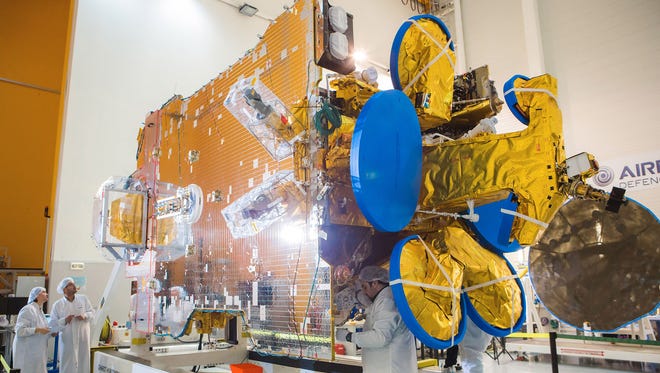Satellite firm confident SpaceX rocket can deliver again

MELBOURNE, Fla. — Martin Halliwell heard the naysayers who said SpaceX would never land and re-fly Falcon rockets, that it was impossible.
Even if Elon Musk’s company did land a first-stage booster, the chief engineer at a competing launch provider once told Halliwell, it would return wrecked, in no condition to fly again.
“Well, here we are,” said Halliwell, chief technology officer at Luxembourg-based satellite operator SES. “We’re at the edge of quite a significant bit of history here.”
SES this week hopes to see its SES-10 communications satellite become the first payload delivered to orbit by a rocket booster that has already completed an orbital launch.
SpaceX is targeting a 6:27 p.m. ET Thursday launch from Kennedy Space Center of a Falcon 9 rocket whose first stage launched for the first time nearly a year ago.
Related: SpaceX will try to prove its rockets are reusable with second launch
Related: Mysterious equipment spotted on SpaceX drone ship
The schedule to be ready is tight, however, and Halliwell warned, it's possible the mission could slip to the same time Friday.
SES is highly confident that the previously flown Falcon booster will offer a safe ride for the nearly 12,000-pound SES-10 spacecraft, which will provide TV and Internet services in Latin America.
“We’ve been through this thing with a fine-toothed comb,” Halliwell said Tuesday at Milliken’s Reef in Port Canaveral, Fla. “SpaceX have been through this with a fine-toothed comb. This booster is a really good booster, and we’re confident.”

In one measure of the mission’s perceived risk, Halliwell said that the insurance rates SES is paying “did not materially change” from a typical launch on a new rocket.
“We don’t believe we’re taking an inordinate risk here,” he said.
The booster will lift off from launch pad 39A with the same nine main engines that fired for more than two minutes last April to help send International Space Station supplies to low Earth orbit for NASA. Minutes later, the booster became the first SpaceX landed intact on a ship at sea.
Related: SpaceX Dragon capsule splashes down in Pacific
Related: SpaceX launches satellite on second try
After launching SES-10, SpaceX will again try to land the booster at sea, though Halliwell said the mission launching the satellite on its way to an orbit more than 22,000 miles up was “right at the limit” of being able to pull off a second landing.
SES received a discount when last August it committed to become the first customer to fly on what SpaceX calls a “flight proven” booster, but Halliwell said he was contractually bound not to say how much.

He said the savings were not significant compared to the satellite’s value, which was not disclosed, and the company's broader interest in advancing the availability of reusable rockets.
“It’s not just the money in this particular case,” he said. “It’s really, let’s get this proof of concept moving. Someone has to go first here.”
Beyond lower launch prices, Halliwell said SES sees reusability benefiting the industry simply by making more rockets available. That could reduce the company’s average seven-month wait time for a launch after a satellite is ready.
Related: SpaceX cargo ship arrives safely at space station
Related: SpaceX launches rocket from historic NASA launchpad
“It’s expensive waiting,” he said.
If schedules hold, SES will fly three more missions with SpaceX this year, and is considering flying two of those on previously flown Falcons, assuming this week’s flight goes well.
Halliwell said SpaceX has allowed SES engineers all the access they needed to be confident that the first re-launched Falcon booster would work as planned.
“The fact that it’s flown once, landed once, that’s just fine,” he said. “Let’s do it again.”
Follow James Dean on Twitter: @flatoday_jdean